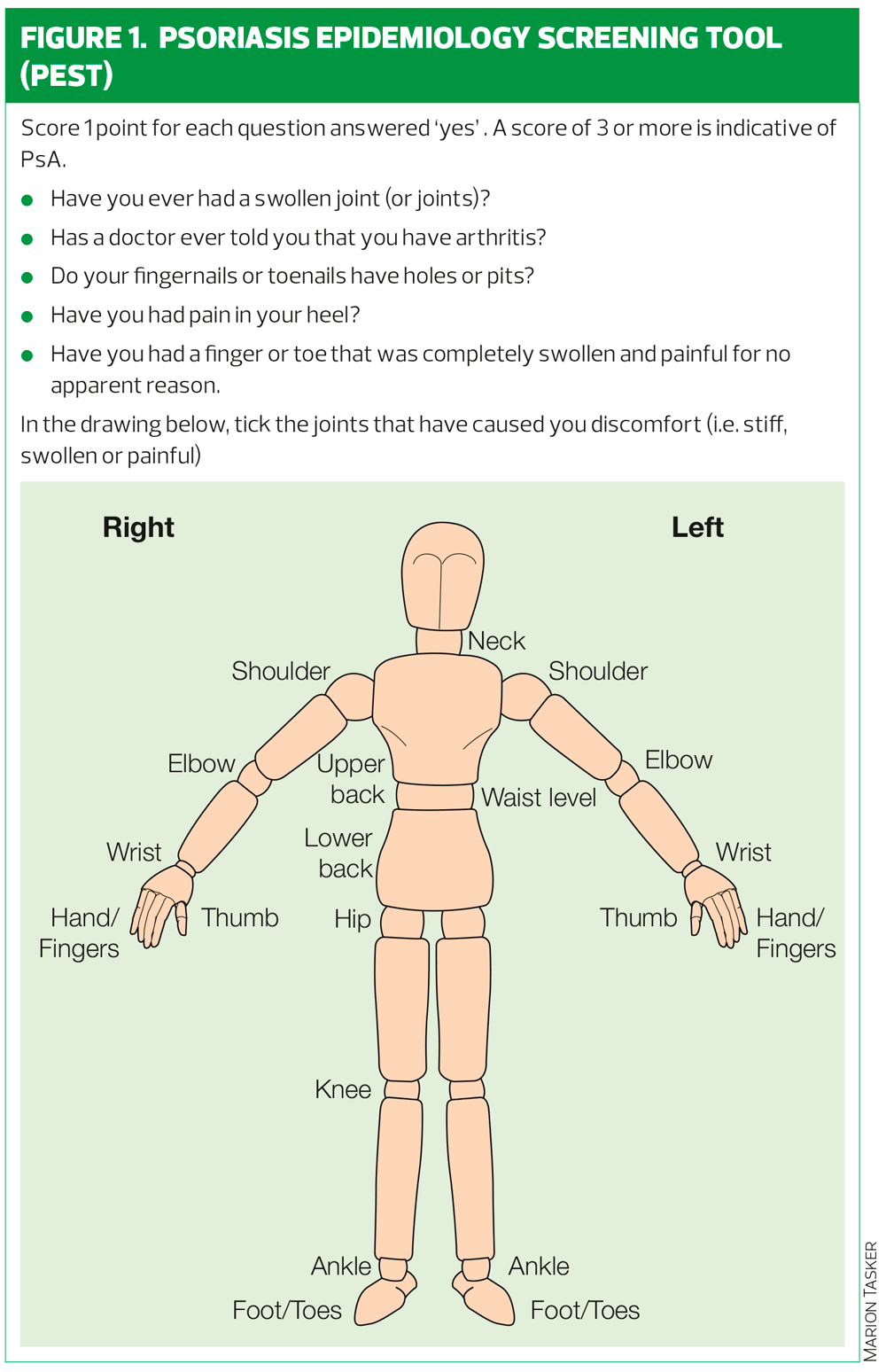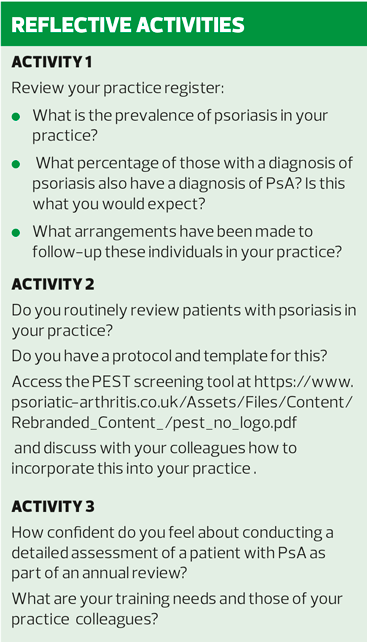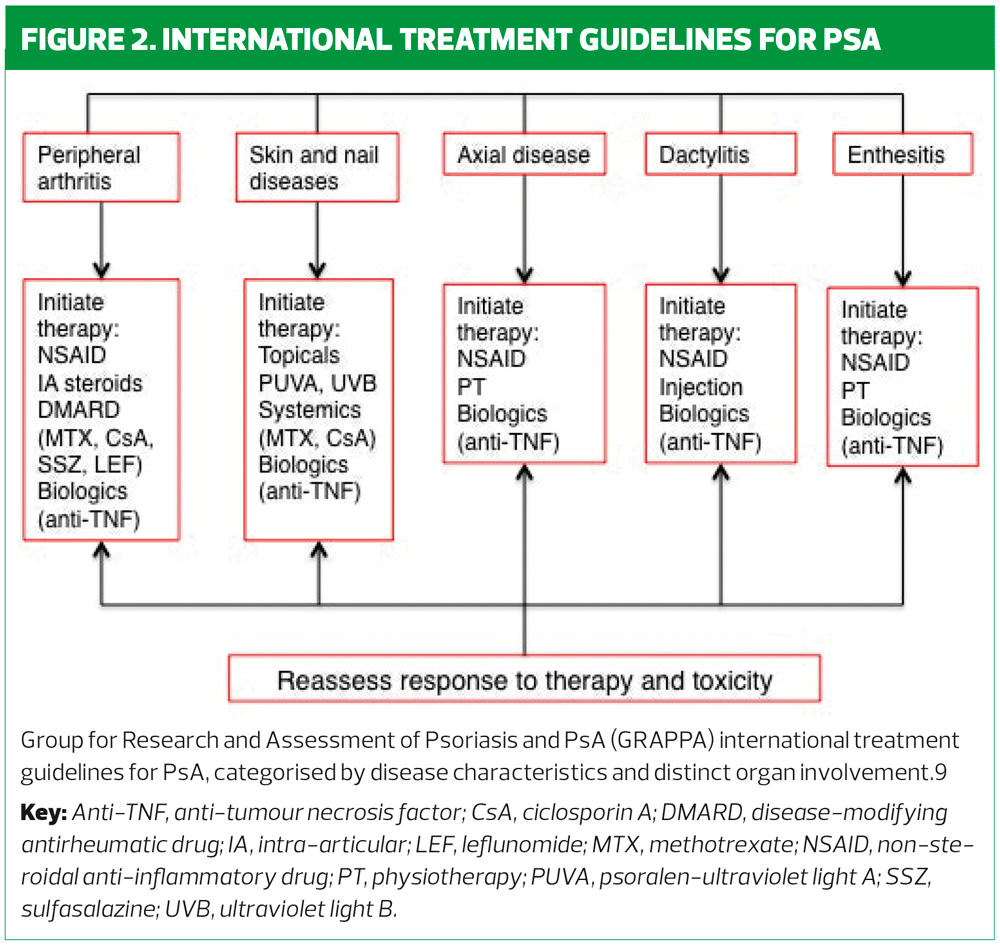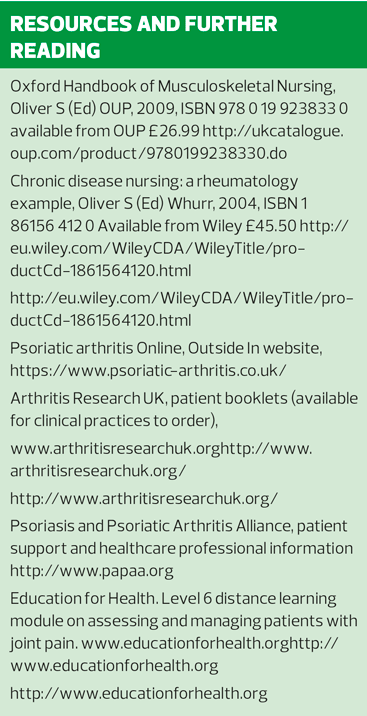Psoriatic arthritis: a case for shared care
Kate Gadsby
Kate Gadsby
RGN, BSc (hons), Dip MedSci NIP
Honorary Rheumatology Nurse Specialist, Royal Derby Hospital
Tricia Cornell
RGN, BSc (hons), NIP
Honorary Senior Rheumatology Practitioner, Poole Hospital NHS Trust
Declaration of Interest: Both authors work as Rheumatology Nurse Consultants for the pharmaceutical company Abbvie Ltd but hold honorary contracts with the NHS
In the first of a series of three articles on inflammatory arthritis, we present a step-wise approach to a case study of psoriatic arthritis and discuss its assessment, diagnosis and management, and the role of the practice nurse in patient care
Psoriatic arthritis (PsA) is a chronic, inflammatory arthritis associated with psoriasis that, if left untreated, can lead to long-term joint damage and disability. It is a seronegative spondyloarthropathy characterised by arthritis, enthesitis (inflammation at tendon, ligament or joint capsule insertions), dactylitis (swelling and inflammation of the digits) and axial inflammation (affecting the axial skeleton i.e. spine, hips and shoulders). While most people develop PsA between the age of 30 and 50, it can present at any age and affects both sexes equally.1–3
In the UK, the prevalence of psoriasis is about 2% with up to 40% of patients with skin or nail psoriasis having PsA. Patients with psoriasis can develop PsA within 10 years of a diagnosis of psoriasis.2–4
While the exact cause of PsA remains unknown, there is a strong genetic element to both PsA and psoriasis, with 40% of patients reporting a family history of psoriasis and/or PsA in first-degree relatives.5
CLINICAL FEATURES
The clinical features of PsA include articular and extra-articular manifestations
- Psoriatic lesions may be present, but in about 15% of people the arthritis starts before the psoriasis2
- Stiffness, pain, swelling, and tenderness of the joints and surrounding ligaments and tendons (dactylitis and enthesitis)1
- Axial features such as stiffness and pain in the spine and sacral iliac joints which can radiate to the buttocks and go up the spine (spondylitis)6
- Dactylitis (or sausage digit), a uniform swelling of a digit caused by inflammation occurring simultaneously in joints, entheses (connective tissue between tendons, ligaments and bone) and tendons
- Enthesitis
- Presence of nail changes such as pitting, onycholysis (painless separation of the nail from the nail bed) and hyperkeratosis (thickening of the nails).6
The symptoms vary from mild to severe with no clear link between the severity of the skin disease and the arthritis. About 40-60% of PsA patients, however, develop erosive and deforming arthritis.1
MUSCULOSKELETAL HISTORY AND EXAMINATION
Key to making an accurate diagnosis in a patient complaining of joint pain is competent history taking and examination of the joints affected. The five key questions that need to be answered for any patient are:
1. Does the problem come from the joint, tendon or muscle?
2. Is the problem acute or chronic?
3. Is it inflammatory or non-inflammatory?
4. What is the pattern of affected joints?
5. What impact is this having on the patient’s life?6
CASE STUDY – PART 1
Jim is a 32-year-old painter and decorator with a two year history of mild psoriasis which has been treated with emollients and coal tar shampoo. While attending your clinic for a medication review, he complains of various problems that have occurred over the past few months: an episode of a painful heel which lasted for about three months, some swelling in his toes, and tiredness and lack of energy.
DIAGNOSIS
The diagnosis of PsA is challenging and GPs may sometimes be unsure of when to refer psoriasis and PsA patients to secondary care.7 The Scottish Intercollegiate Guidelines Network (SIGN) recommends that all patients with suspected PsA should be assessed by a rheumatologist in order to establish an early diagnosis and to reduce joint damage.
Patients with psoriasis should have an annual reassessment for symptoms of arthritis using a validated screening tool for PsA, such as the Psoriasis Epidemiology Screening Tool (PEST). This is a patient-administered screening questionnaire and can be used annually for early detection of PsA in patients with psoriasis.2,7 (Figure 1) A total score of 3 or more out of 5 is considered to be positive and requires a referral to rheumatology.
INVESTIGATIONS
A vital part of the management of suspected PsA, and where primary care has a pivotal role, is early referral to a rheumatologist for diagnosis and treatment. Up to 47% of PsA patients will have radiological changes at two years despite treatment with disease modifying anti-rheumatic agents.4
Laboratory tests are unspecific. The rheumatoid factor is usually negative and only about 40% of patients with PsA will have a raised erythrocyte sedimentation rate (ESR).5,9 Ultrasound is increasingly being used by rheumatologists as it can detect enthesitis and can differentiate between synovitis and enthesitis. More recently, the use of magnetic resonance imaging (MRI) has been used to detect early signs of joint synovitis and diagnose PsA.5
DIFFERENTIAL DIAGNOSIS
Rheumatoid arthritis (RA) is the main differential diagnosis. While fewer joints are typically involved in PsA compared with RA, the same joints may be involved, e.g. the small joints of the hands. Other factors that differentiate PsA from RA include the presence of distal interphalangeal (DIP) joint involvement, relative asymmetry, an absence of subcutaneous nodules and a negative test result for rheumatoid factor.
Other conditions that could be wrongly diagnosed as PsA include:
- Gout
- Osteoarthritis
- Fibromyalgia
- Reactive arthritis
- Septic arthritis.2,5
CASE STUDY – PART 2
Following careful history-taking, a suspicion of PsA, based on three months of a painful heel (probable achilles enthesitis), dactylitis with associated early mornings stiffness, and systemic features of fatigue, prompts you (appropriately) to seek advice from the GP with a view to referring him to a rheumatologist.
Jim is seen by a rheumatologist and diagnosed as having PsA. He is prescribed methotrexate, a disease-modifying anti-rheumatic drug (DMARD), for active PsA.
ASSOCIATED CONDITIONS
PsA, in common with other inflammatory arthropathies, is associated with depression, cardiovascular disease, hypertension, hyperlipidemia and type 2 diabetes.7
THE ROLE OF THE PRACTICE NURSE
Co-morbidity
A practice nurse involved in the care of people with psoriasis and PsA needs to be aware of the possible comorbidities these people are at risk of and be able to conduct detailed assessment to accurately identify and manage them.7
The impact that this condition can have on quality of life should not be overlooked or underestimated. Depression is a common co-morbidity. In addition, patients should be advised about their risk of cardiovascular disease and be given appropriate life-style advice and support to reduce their risk. Body mass index, diabetes screening, blood pressure measurement and lipid profile form an important part of annual review.7
TREATMENT
The aim of initial PsA management is to suppress inflammation in the joints, tendons, entheses and skin.3 Aggressive treatment of early, progressive PsA can help improve prognosis.4 The associated skin disease should be treated at the same time.
The Group for Research and Assessment of Psoriasis and PsA (GRAPPA) has produced international guidelines for the management of PsA which are categorised by disease characteristics and distinct organ involvement.9 (Figure 2) (In the author’s experience initial therapy for dactylitis and enthesitis can also be an injection of corticosteroid.)
Treatment options for PsA include:
- Non-drug and self-management options such as exercise and physiotherapy, diet, lifestyle advice10
- Drug treatment including analgesics, NSAIDs, local corticosteroid injections, DMARDs and biologics4
- In later disease, patients with damaged joints or those who need joint replacement are likely to benefit from surgery.10
CASE STUDY – PART 3
Three months post diagnosis, Jim is established on methotrexate and a letter from the hospital asks you to take over drug monitoring as he is doing well. However, he has been having problems coping with work and feels depressed.
SHARED CARE PATHWWAY
SIGN recommends the implementation of a shared care pathway between primary and secondary care for the management of PsA.7 Shared care requires the agreement of all parties, including the patient. Effective communication and continuing liaison between all parties are essential.11
TREATMENT
DMARDs aim to reduce joint damage and improve outcomes. The choice and sequence of DMARD should take into account:
- Patient preference
- Severity of joint disease
- Severity of skin disease
- Comorbidities
- Risk of adverse reactions.7
NICE recommends methotrexate and sulfasalazine as the DMARDs of choice in polyarticular disease that has not responded to NSAIDs. DMARDs are slow acting and it can take up to twelve weeks before a response to treatment is noticed.
THE ROLE OF THE PRACTICE NURSE
Assessment and monitoring
At this stage, as part of the primary care team, the practice nurse can be involved in patient assessment and DMARD monitoring, looking for adverse events and communicating with the rheumatology team as appropriate. They will also have a key role in providing support to patients like Jim.
Patients with psoriasis and PsA have a high risk of depression, and an associated reduction in quality of life.7 Advice on self-management skills, the importance of adherence to treatment, maintaining a healthy lifestyle, as well as counselling and relationship support can form an important part of your role. If necessary patients should be referred for psychological support.
DMARDs can suppress the immune system and it is recommended that patients taking them are given pneumococcal vaccine and the annual influenza vaccine.
SELF-MANAGMENT
People with PsA should be advised about how to cope with this long-term condition and encouraged to use self-management strategies.7 The use of consultation skills, such as motivational interviewing techniques, can help patients take or regain control and become an informed and active partner in shared decision making.
CASE STUDY – PART 4
Two years later, Jim is treated with a further DMARD (leflunomide) as he is unable to tolerate an increased dose of methotrexate. He is not doing well and has started to deteriorate. His next option is a biological agent. This will require further consultation with the specialist team in secondary care.
BIOLOGICAL AGENTS
NICE recommends the use of biological agents (biologics) in patients with active and progressive PsA who have three or more tender and swollen joints and who have already tried and failed on at least two DMARDs.4,12,13
Adalimumab, etanercept, golimumab, infliximab and ustekinumab are currently recommended for the treatment of adults with active and progressive psoriatic arthritis. Two further biological agents, certolizumab pegol and secukinumab, are currently under review, and awaiting NICE approval.
Adalimumab, etanercept, golimumab and ustekinumab are given by subcutaneous injection and patients are usually taught to self-administer their drug therapy.4,12,13 Infliximab is given by slow intravenous infusion in an out-patient setting.
Monitoring biological agents
Biologics are generally initiated and prescribed in secondary care.4 PsA Response Criteria (PsARC) are used to assess response to biologic agents in patients with PsA. These criteria assess 68 joints for tenderness, 66 joints for swelling and includes a patient and healthcare professional assessment of global wellbeing using a Likert scale of 0–5.7
The side effects profiles of the biologics are similar across the therapeutic class. As a group there is a small increased risk of infections and these include a possible increased risk of food related infections. As a practice nurse you will need to be diligent when assessing patients taking these medications to ensure that infections are treated swiftly to prevent further complications.14 The British Society for Rheumatology recommends that treatment with biologics should:
- Be stopped in case of atypical or opportunistic infections
- Not be started or continued in case of active infectious disease, and
- Patients on biologic agents should be educated about food hygiene.3
Patients commencing biologic therapies are screened for mycobacterial infections in line with the latest national guidelines, and active mycobacterial infection should be adequately treated before anti-TNF (tumour necrosis factor) therapy is started.3
In patients with PsA and significant skin disease there is an increased risk of skin malignancy due to self-directed excess ultraviolet (UV) exposure, or as a result of phototherapy. Regular skin surveillance and screening for skin malignancies, including melanoma, is therefore key for PsA patients on biologics. Patients who develop suspicious skin lesions during biologic treatment should be referred urgently for assessment by a dermatologist.3
CONCLUSION
Patients with PsA need early diagnosis and treatment, to effectively control skin and joint manifestations of the disease and to prevent joint damage and maintain the patient’s quality of life.7 Patients need to be at the heart of the shared decision making process; effective communication and continuing liaison between the patients and healthcare professionals should be established in order to reach a shared care agreement.11
Practice nurses, alongside Rheumatology Specialist Nurses, play an important role in supporting patients through the diagnosis, educating them about the condition, monitoring drug therapy and working with them to develop self-management techniques to lessen the impact that PsA has on their lives.
REFERENCES
1. Gottlieb A. Guidelines of care for the management of psoriasis and psoriatic arthritis:
section 2. Psoriatic arthritis: overview and guidelines of care for treatment with an emphasis on the biologics. J Am Acad Dermatol 2008;58:851-864
2. Helliwell P. Psoriatic Arthritis; Its presentation and management in primary care. Arthritis Research UK. Hands on. Reports on the rheumatic disease series. 2009 Summer No 3
3. The British Society for Rheumatology (BSR) and British Health Professional in Rheumatology (BHPR) Guideline for the treatment of psoriatic arthritis with biologics Rheumatology 2013;52:1754-1757
4. National Institute for Health and Care Excellence. Etanercept, infliximab and adalimumab for the treatment of psoriatic arthritis. Technology Assessment 199. August 2010 NICE. London. http://www.nice.org.uk/guidance/ta199/resources/guidance-etanercept-infliximab-and-adalimumab- for-the-treatment-of-psoriatic-arthritis-pdf
5. Al Hammadi A, Badsha H. Psoriatic Arthritis Overview of Psoriatic Arthritis, Medscape, June 2012
http://emedicine.medscape.com/article/2196539-overview
6. Arthritis Research UK. Psoriatic arthritis booklet. 2011 April. ARUK
7. Scottish Intercollegiate Guidelines Network. Guidelines on the diagnosis and management of psoriasis and psoriatic arthritis in adults. October. 2010 SIGN Edinburgh http://www.sign.ac.uk/guidelines/fulltext/121/recommendations.html#
8. Van Eijk Hustings, Y Bostrom C, Van Tubergen A et al. EULAR recommendations for the role of the nurse in the management of chronic inflammatory arthritis. Ann Rheum Dis 2012;71:13-19
9. Ritchlin CT, Kavanaugh A, Gladman DD, et al. Treatment recommendations for psoriatic arthritis. Ann Rheum Dis 2009;68:1387-1394 doi:10.1136/ard.2008.094946
10. Arthritis Research UK. Clinical assessment of the musculoskeletal system. A guide for medical students and healthcare professionals. 2011 April. ARUK
11. General Medical Council. Good practice in prescribing medicines and devices. Shared care 2013 (p 35-43) January. GMC http://www.gmcuk.org/static/documents/content/Prescribing_guidance(1).pdf
12. National Institute for Health and Care Excellence. Golimumab for the treatment of psoriatic arthritis. Technology Appraisal Guidance 220. 2011 April. NICE. London http://www.nice.org.uk/guidance/ta220/resources/guidance-golimumab-for-the-treatment-of-psoriatic- arthritis-pdf
13. National Institute for Health and Care Excellence. Ustekinumab for treating active psoriatic arthritis. Technology Appraisal Guidance 340. 2015 June . NICE. https://www.nice.org.uk/guidance/ta340/chapter/2-The-technology London
14. Singh JA, Wells GA, Christensen R,et al. Adverse effects of biologics: a network meta-analysis and Cochrane overview. Cochrane Database of Systematic Reviews 2011, Issue 2. Art. No.: CD008794. DOI: 10.1002/14651858.CD008794.pub2.



